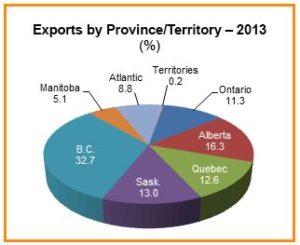 Canada has a pushy trading partner called China and that “partner” is throwing its weight around currently by:
Canada has a pushy trading partner called China and that “partner” is throwing its weight around currently by:
- Removing China’s (nasty) ambassador to Canada
“…Lu has made a series of damning remarks about Canada-China relations in recent months”… SOURCE
. - Arresting Canadians in China on what appears to be spurious grounds
“…The retaliatory arrest of Canadians Michael Kovrig and Michael Spavor on spurious national security grounds… have brought Canada-China relations to their lowest ebb since the establishment of diplomatic relations in 1970.” SOURCE
. - Spontaneously re-sentencing existing convicted Canadians to much harsher sentences including death
“…The retrial was scheduled for barely two weeks later, and the verdict and sentence were reportedly handed down Monday with little deliberation.” SOURCE
. - Blocking the importation of Canadian goods
“…China is ‘inventing excuses’ to block shipments of Canadian canola, Trudeau says.” SOURCE
. - Attempting to bully Canada and its politicians through public warnings
“China warns Canada not to be ‘naive’ in thinking allies can help fix dispute” SOURCE
. - Blocking Chinese students, already in Canada, from attending Canadian universities and colleges with very short notice
“…China orders international students home, some Canadian schools face money trouble” SOURCE
These tactics are all linked to the arrest of Huawei CFO Meng Wanzhou under an international warrant issued by the United States.
 You would think that China and Canada have a massive reciprocal trade relationship, and it is in fact large. However, it is not near as large or important as you have likely heard. Canada exports just 3% of its products (nearly all raw materials like coal and canola) to China and imports just 6% of its products from China.
You would think that China and Canada have a massive reciprocal trade relationship, and it is in fact large. However, it is not near as large or important as you have likely heard. Canada exports just 3% of its products (nearly all raw materials like coal and canola) to China and imports just 6% of its products from China.
You can see in the chart to the right that British Columbia has the most to loose if China gets cranky. For certain, those are not insignificant numbers especially in the few industries that trade is concentrated in. But it is also clear that there is no scenario in which that trade would go to zero. China needs to import Canada’s products and wants to export theirs.
Also, much like when your work computer has a problem or when you car breaks down you don’t stand still and do nothing. You do something else to be productive and Canadian businesses have and will do just that. The short video below from BNN Bloomberg explains that while Chinese tourism is well down, Canada’s tourism numbers are up over all.
Canadian hotels and airlines did not just throw up their hands and go to lunch when Chinese tourists cancelled their Canadian visits. They did exactly what you would do, which is to find other markets to fill those seats. The Canadian mining and agriculture industries will do exactly the same thing. It will hurt to loose a large customer like China but unlike hotel rooms, nickle and canola can be stored for a while to allow time for other markets to be found.
Most of the Canadian products shipped to China are global commodities that take time to produce and have long cycle contracts. This means that if China orders more from someone other than Canada, that selling country leaves a hole in the market where it was going to sell the products before China bumped up its order. This is basic economics and while it is definitely not trivial or easy for those involved, the products will get sold… just to someone else.
So Canada doesn’t trade near as much with China as most people think and what Canada and China do trade can all be bought/sold from alternate sources without collapsing either economy.



0 Comments